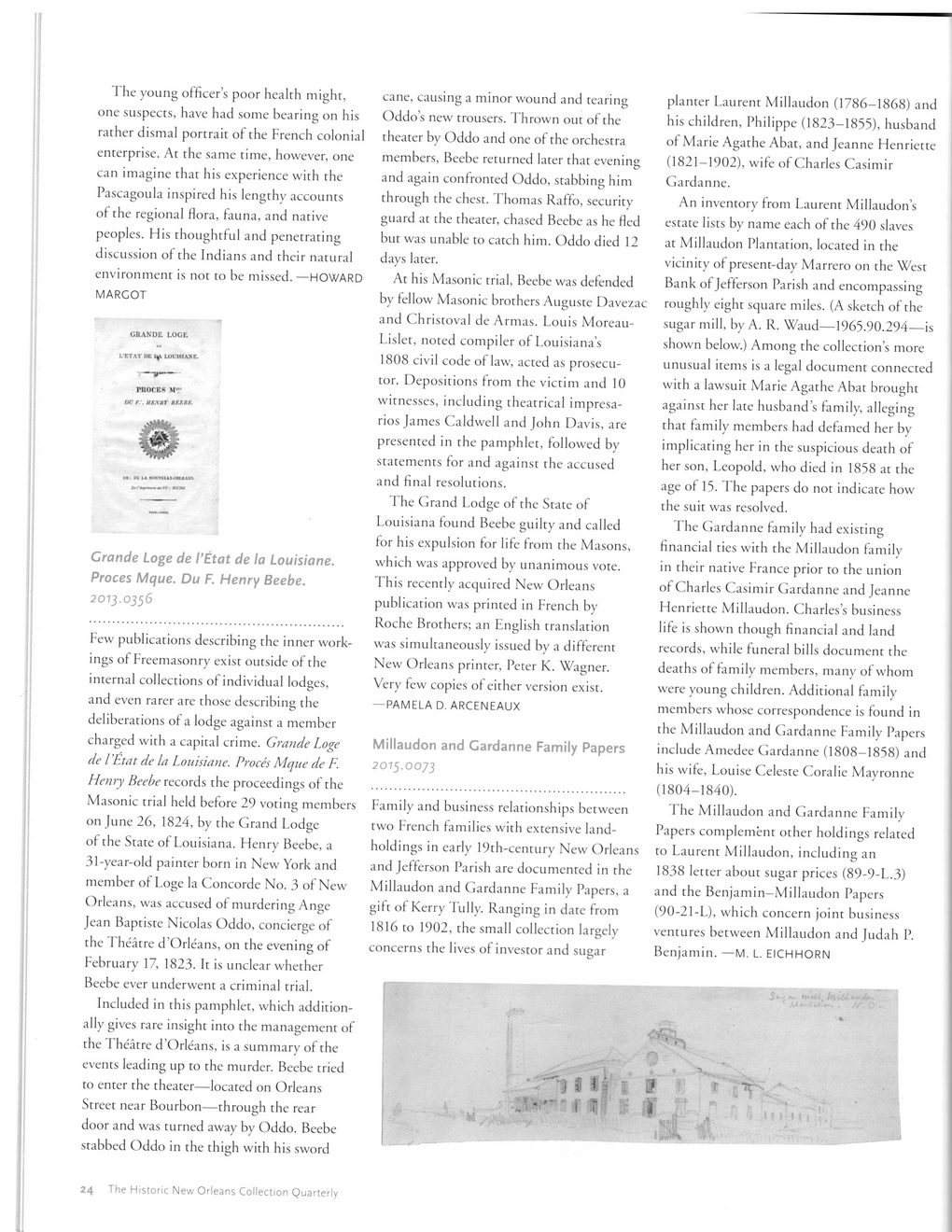This text was obtained via automated optical character recognition.
It has not been edited and may therefore contain several errors.
1 he young officer’s poor health might, one suspects, have had some bearing on his rather dismal portrait of the French colonial enterprise. At the same time, however, one can imagine that his experience with the Pascagoula inspired his lengthy accounts of the regional flora, fauna, and native peoples. His thoughtful and penetrating discussion of the Indians and their natural environment is not to be missed. —HOWARD MARGOT GRAN'DE LOGE LTTAT I* LOCBIAKE. PROCHS M*’ DV F.\ HK.VIT »K£BK. U.NU MMIIHMIHI Grande Loge de I'Etat de la Louisiane. Proces Mque. Du F. Henry Beebe. 2013.0356 Few publications describing the inner workings of Freemasonry exist outside of the internal collections of individual lodges, and even rarer are those describing the deliberations of a lodge against a member charged with a capital crime. Grande Loge de I’Etat de la Louisiane. Proces Mque de F. Henry Beebe records the proceedings of the Masonic trial held before 29 voting members on June 26, 1824, by the Grand Lodge of the State of Louisiana. Henry Beebe, a 31-year-old painter born in New York and member of Loge la Concorde No. 3 of New Orleans, was accused of murdering Ange Jean Baptiste Nicolas Oddo, concierge of the Theatre d’Orleans, on the evening of February 17, 1823. It is unclear whether Beebe ever underwent a criminal trial. Included in this pamphlet, which additionally gives rare insight into the management of the Theatre d’Orleans, is a summary of the events leading up to the murder. Beebe tried to enter the theater—located on Orleans Street near Bourbon—through the rear door and was turned away bv Oddo. Beebe stabbed Oddo in the thigh with his sword cane, causing a minor wound and tearing Oddo’s new trousers. Thrown out of the theater by Oddo and one of the orchestra members, Beebe returned later that evening and again confronted Oddo, stabbing him through the chest. Thomas Raffo, security guard at the theater, chased Beebe as he fled but was unable to catch him. Oddo died 12 days later. At his Masonic trial, Beebe was defended by fellow Masonic brothers Auguste Davezac and Christoval de Armas. Louis Moreau- I.islet, noted compiler of Louisiana’s 1808 civil code of law, acted as prosecutor. Depositions from the victim and 10 witnesses, including theatrical impresarios James Caldwell and John Davis, are presented in the pamphlet, followed bv statements for and against the accused and final resolutions. I he Grand Lodge of the State of Louisiana found Beebe guilty and called for his expulsion for life from the Masons, which was approved by unanimous vote. This recently acquired New Orleans publication was printed in French by Roche Brothers; an English translation was simultaneously issued by a different New Orleans printer, Peter K. Wagner. Very few copies of either version exist. — PAMELA D. ARCENEAUX Millaudon and Cardanne Family Papers 2015.0073 Family and business relationships between two French families with extensive landholdings in early 19th-century New Orleans and Jefferson Parish are documented in the Millaudon and Gardanne Family Papers, a gift of Kerry Tully. Ranging in date from 1816 to 1902, the small collection largely concerns the lives of investor and sugar planter Laurent Millaudon (1786-1868) and his children, Philippe (1823-1855), husband of Marie Agathe Abat, and Jeanne Henriette (1821-1902), wife of Charles Casimir Gardanne. An inventory from Laurent Millaudon’s estate lists by name each of the 490 slaves at Millaudon Plantation, located in the vicinity of present-day Marrero on the West Bank of Jefferson Parish and encompassing roughly eight square miles. (A sketch of the sugar mill, by A. R. Waud—1965.90.294—is shown below.) Among the collection’s more unusual items is a legal document connected with a lawsuit Marie Agathe Abat brought against her late husband’s family, alleging that family members had defamed her bv implicating her in the suspicious death of her son, Leopold, who died in 1858 at the age of 15. The papers do not indicate how the suit was resolved. The Gardanne family had existing financial ties with the Millaudon family in their native France prior to the union of Charles Casimir Gardanne and Jeanne Henriette Millaudon. Charles’s business life is shown though financial and land records, while funeral bills document the deaths of family members, many of whom were young children. Additional family members whose correspondence is found in the Millaudon and Gardanne Family Papers include Amedee Gardanne (1808-1858) and his wife, Louise Celeste Coralie Mavronne (1804-1840). The Millaudon and Gardanne Familv Papers complement other holdings related to Laurent Millaudon, including an 1838 letter about sugar prices (89-9-L.3) and the Benjamin-Millaudon Papers (90-21 -L), which concern joint business ventures between Millaudon and Judah P. Benjamin. —M. L. EICHHORN 24 The Historic New Orleans Collection Quarterly

New Orleans Quarterly 2015 Summer (26)